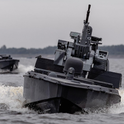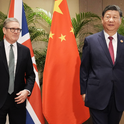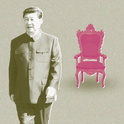More than a year after Russia invaded Ukraine, there is no end in sight to the conflict. Since 24th February 2022, Russia has adapted its military strategy in response to successive setbacks, including its failed blitzkrieg on Kyiv and the reversal of its advances in the annexed regions of southern and eastern Ukraine. However, its overall political goal is unchanged.
This point was brought home to me recently when I spoke to a former Russian colleague whom I had not seen since the outbreak of the conflict. Unlike others I’d kept in touch with, he has publicly backed Putin’s war. He bluntly explained to me that Moscow’s aim continues to be that of “eliminating anti-Russian elements” in Ukraine and eventually imposing a “Chechen solution” on the country.
When I asked him whether Moscow still believed this was feasible, he wavered only slightly. Yes, he conceded, those “anti-Russian elements” may be more numerous than anticipated, making the establishment of a pro-Russian regime in Ukraine—the Chechen solution—neither easy nor immediate. But, he said, Russia could simply not afford to lose this war. If it did, the Russian state could implode.
Russia’s invasion of Ukraine has morphed in the establishment’s psyche into the 21st-century equivalent of the “Great Patriotic War”, the term still used today in Russia to describe its involvement in the Second World War. My interlocutor’s words were surreal, but I took them seriously. Russia has started digging a hole, and the more it comes to realise it is in one, the deeper it will continue to dig.
Since the war began, Ukraine’s political goals have also only been consolidated. The abstract concept of territorial integrity has become a concrete question of survival. Massacres in the now-liberated lands of Bucha, Irpin, Kharkiv and Kherson have persuaded Ukrainians that they cannot leave the occupied areas of Mariupol, Melitopol or Luhansk behind. The more that Ukrainians—in particular the Russian-speakers of the east and south—realise what it would mean to live under the Kremlin’s thumb, the more they are prepared to give their lives to fight it. Eliminating the “anti-Russian elements in Ukraine”, to use my former colleague’s bizarre expression, would now essentially amount to eliminating the entire country.
Ukraine’s military successes have persuaded government and people alike that they can not only hold onto Kyiv—the most fundamental goal at the outset of this war—but free their whole country, including Donbas and Crimea. Behind the goal of defeating Russia there is now not only a wish for revenge, but the drive to end, once and for all, Russia’s imperial ambitions. Peace, not just in Ukraine but in eastern Europe and the Caucasus, hinges on Ukraine achieving this goal.
* * *
Looking ahead into the spring and summer, what can we expect? And how could Ukraine’s allies influence the outcome of the war?
In carrying out its renewed offensive, Russia appears set on a military strategy that assumes quantity trumps quality: it keeps throwing men and missiles into Ukraine, despite the poor training of its troops and precision of its weapons, believing that sooner or later it will prevail. The battle for Bakhmut, which Russian forces have been obstinately pursuing for nine months, epitomises this approach.
Russia is likely to be proved wrong. Just how much western weaponry reaches Ukraine, and when it gets there, is crucial. Quantity matters, but so does quality—and arguably more so. The technological superiority of western weaponry delivered to Ukraine; the mid- to long-term effect of western technology export controls in limiting Russia’s industrial capacity; and the higher morale of Ukrainian soldiers will continue to come up against the brute force of Russia’s military onslaught. As and when Ukraine launches its new counteroffensive—perhaps in late spring or early summer—it is not unrealistic to assume that its forces will liberate more territory, even if their advances slow down the closer they get to 24th February lines and beyond.
Does this mean that the die of the war is cast? Unfortunately not. Russia’s strategy involves politics as well as the military. Moscow aims to break Ukrainian resistance by bringing the country to its knees—destroying its energy system and attacking civilians—in the belief this will pressure the government into accepting a “compromise” that means capitulation to Russia’s desires. In this respect, it will not succeed. Ukraine will stand firm.
Russia appears set on a military strategy that assumes quantity trumps quality... Russia is likely to be proved wrong
A more open question is whether the second leg of Russia’s political strategy, aimed at weakening western support for Ukraine, will bear fruit. Through the weaponisation of energy, the threat of nuclear war, attacks on critical infrastructure and proliferation of Russian disinformation, the Kremlin has aimed at dividing the west and diminishing western support for Ukraine.
More than a year into the war, American support for Ukraine remains remarkably high: polls show that at least two-thirds of the public still back giving the country military and economic assistance. In January, Biden promised to provide Kyiv with Patriot air defences and Abrams tanks. This support looks set to carry on in the months ahead.
The real question is whether US support will remain as strong as Americans head towards presidential elections in 2024, let alone what might happen thereafter if a Republican candidate wins the presidency. Without diminishing the potential role that German-made Leopard tanks could play in the months ahead, it is US military support for Ukraine, which outstrips in absolute terms the assistance provided by all other countries, that will be the key ingredient in ensuring Russia’s military defeat.
The possibility that US backing might wane next year, added to the growing realisation that Moscow is unwilling to engage in meaningful talks, can explain the recent and decisive uptick in western military support for Ukraine, from the delivery of air defence systems to the commitment of tanks and the likely promise of fighter jets in the near future. In this respect, there is greater transatlantic agreement, including in European capitals like Berlin and Paris that have in the past been more prone to seeking negotiations with Moscow. There are no illusions, either in Europe or in North America, that peace talks with Russia are feasible at present. Instead, there is a growing acceptance that, as the war rages on, the west must go on supporting Ukraine militarily. However, if the US can determine more than any other nation whether Russia loses the war, Europe can influence whether Ukraine is actually capable of winning it.
* * *
Prevailing on the battlefield is a necessary but insufficient condition for victory. Just as important is the extent to which Ukraine can emerge from the war with a strong democracy, a prosperous economy and a well-governed state that is free from corruption. Europe, far more than the US, can make the difference in this respect. This is why Russia’s political strategy aims at breaking European resolve and sowing divisions within the European Union.
One way could be through migration. Since 24th February, 18m people have fled Ukraine; the number returning has steadily increased as the war continues, but more are still leaving than returning. According to the UNHCR, eight million (or 19 per cent of the population) are now elsewhere in Europe. It is highly unlikely that Europeans will keep on welcoming refugees with the same spirit of solidarity as they did in the war’s early days.
And migration from outside Europe, which had temporarily dropped off the political radar, is drawing attention once more. The flow of incomers, especially across the southern frontiers of the EU, has returned to levels not seen since the migration crisis seven years ago. With growing economic hardship in many European countries combined with higher numbers of migrants reaching their soil, European resilience and the ability of nations to share the burden will increasingly be put to the test.
Then there is the energy crisis. Thanks to energy diversification, a warm winter, high gas storage levels and reduced demand, Europeans made it through the cooler months better than many feared. Dependence on Russian gas fell from 40 per cent to around 8 per cent on average, with countries like Germany breaking free altogether—a year ago, no one dreamt this could be possible.
Other initiatives, from capping oil and gas prices to accelerating investment in renewables, developing schemes for jointly procuring gas and restructuring electricity markets have also progressed. The economic slowdown from the energy crisis does not appear as severe as some originally worried. Despite a remarkable drop in gas consumption, industrial production so far has not been affected significantly, even in countries like Germany and Italy whose industry relies heavily on gas.
It is difficult to imagine a political dynamic that would lead European countries to abandon Kyiv wholesale and all who defend it. However, it remains unclear whether European efforts will be sufficient to ensure that Ukraine is victorious
However, Europeans may struggle to refill gas storages through this spring and summer in preparation for the winter between 2023 and 2024. Added to the cost of living crisis, the gas rationing Europeans are escaping as spring arrives could come back to haunt us the next time temperatures drop. All this compounds growing fears of Europe’s pending deindustrialisation: energy prices remain structurally high in Europe.
Meanwhile in the US, prices have fallen from their peak and are expected to drop further as it begins to experience the massive injection of public funds promised through the $370bn Inflation Reduction Act. European industries, notably those specialising in green technologies, may be lured to relocate to the other side of the Atlantic. Squeezed between the Scylla of soaring energy prices and the Charybdis of US subsidies for its green technologies, Europe faces the spectre of deindustrialisation.
Notwithstanding total refugee fatigue and the energy crisis, it is difficult to imagine a political dynamic that would lead European countries to abandon Kyiv wholesale and all who defend it. However, it remains unclear whether European efforts will be sufficient to ensure that Ukraine is victorious and that it emerges from war as a strong democracy with a successful economy.
The EU’s member states and institutions have been channelling money into military support for Ukraine—a historic total of €12bn by March 2023—on top of financial assistance. Overall, the EU has provided over €67bn worth of support already, meaning it surpasses the US as Ukraine’s biggest financial supporter. To date, Washington has channelled over $51bn in security, humanitarian and economic assistance to Kyiv, although more is to come. Already, Congress has approved $113bn through to 2026.
Officials in the European Commission are beginning to explore how much they may be able to contribute from the EU budget to Ukraine’s reconstruction, when the time comes. The total bill is likely to run into the hundreds of billions, and much of this financial burden will rest on European shoulders. As of today, it is highly uncertain whether this money will appear and, if it does, where it would come from.
So far as European sanctions on Russia go, further packages are expected to be added this year to the 10 already approved. These are unlikely to be as significant as the sanctions already in place, but they do indicate that the screws will not be loosened any time soon. If anything, they will be tightened further in the coming months.
* * *
Then, finally, there is the question of Ukraine’s accession to the EU. Since the bloc recognised Ukraine’s candidate status in June 2022, Kyiv has been formally on the path to full membership. This too is a decision that will not be reversed. However, there is a real risk that Ukraine’s expectations will not be met. Kyiv would like to see a speedy entry into the bloc, with Ukraine’s prime minister, Denys Shmyhal, positing a two-year horizon for membership. It is highly unlikely to happen that fast and Ukraine’s accession course could end up following the same fraught journey as states in the western Balkans or Turkey.
There remains huge disagreement among EU member states concerning the timeframe: eastern European countries are pushing for Ukraine’s accession to be fast tracked and completed in five years, but others (notably in western Europe) believe that membership would take at least a decade given ongoing concerns about corruption, governance and what kind of country will emerge from the ashes of war. A few member states, first and foremost France, silently harbour the hope that Kyiv will instead opt for the European Political Community, which brings together 44 countries, not all of which are EU members.
Added to this is the question of whether Europeans are willing to provide the necessary security guarantees for Ukraine. Whereas the EU is not a military alliance like Nato, its solidarity and mutual assistance clauses imply that all member states would have to commit to standing with Ukraine were its security to be threatened again by Russia.
This said, given that Ukraine’s economic reconstruction is probably going to depend primarily on Europe, and that the necessary funds cannot realistically come only from public coffers, it will be essential to mobilise the private sector in this effort. This sector will only invest in Ukraine if appropriate security and rule of law conditions apply. This requires not only European integration, but security guarantees like those in Nato’s Article Five. Hence, over time, there may be a growing realisation in Europe that Ukraine’s Euro-Atlantic integration has become both a security necessity as well as an economic imperative.
The EU’s position towards Russia is far more uncertain. Between 2014—when Russia annexed Crimea and intervened in Donbas—and the 2022 full-scale invasion of Ukraine, Europeans had a policy for dealing with Russia but no policy for dealing with Kyiv. The EU essentially had a two-pronged approach vis-à-vis Moscow, consisting of sanctions and selective engagement on areas of common interest, from the Iran nuclear deal to the energy transition. When it came to Ukraine, leaders essentially stuck their heads in the sand; in retrospect the Minsk agreements, intended to end conflict in Donbas, gave them the perfect excuse to do so.
There is no long-term vision for Russia and Europe’s relationship with it
Today, exactly the opposite is true. Europeans may debate whether they are giving sufficient military or financial support, solidarity towards refugees or commitment about EU membership, but overall there is a clear policy approach with a strong strategic rationale.
When it comes to Russia, European leaders know what they are doing today: sanctions are aimed at progressively reducing Russia’s ability to wage war, and energy initiatives are intended to decouple western energy security from Russia to prevent Moscow from weaponising supplies and flows in future. But there is no long-term vision for Russia and Europe’s relationship with it.
This is because it is impossible to gauge what kind of country will emerge from Russia’s strategic defeat in Ukraine. Will the incumbent in the Kremlin remain unscathed or will a post-Putin Russia emerge? Would that post-Putin Russia be equally authoritarian or more democratic and post-imperial? Will the Russian state implode? Will a severely diminished Russia settle into becoming China’s poor and servile cousin or will it remain a European power? As of today, it is impossible to predict Russia’s trajectory, making it even harder to reflect on how we should think about our future relationship with Moscow.
The Ukraine war has crystallised a contradiction. On the one hand, the west has united in response to Russian aggression and proved that, when it sticks together, it is a force to be reckoned with; on the other, the war has been a reminder that the world does not revolve around us. Most countries, while not siding with Russia, have equally preferred not to put all their eggs in the western basket. Some, like Turkey, the Arab Gulf states or India have hedged, extracting value from sitting on the fence. Most countries in Africa, Asia and Latin America don’t share Ukraine and the west’s preoccupations with the war; they simply have other priorities in mind. We already live in a non-polar world.
Europeans will have to accept there is little that we can do directly to influence Russia’s future. Our power and influence simply do not stretch that far. As disastrous as Russia’s implosion or its submission to China would be, not only for Russia but for Europe too, there is little that we can do to prevent such outcomes. We can only strengthen our collective resilience, and that of Ukraine, and learn to live with the choices that Russia will eventually make.
Correction: The model of tanks promised by the US government to Ukraine were originally referred to in this article as Abrahams tanks. They are Abrams tanks.















